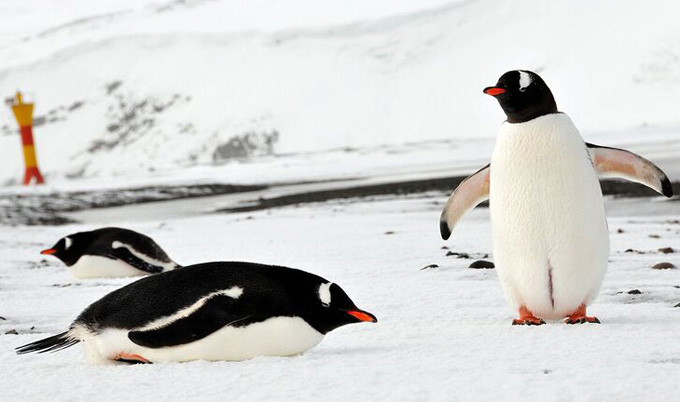Penguin colonies
Antarctic penguin colony repeatedly decimated by volcanic eruptions
Published on: 11 April 2017
One of the largest colonies of gentoo penguins in Antarctica was decimated by volcanic eruptions several times during the last 7,000 years according to a new study.
Close to extinction
An international team of researchers, including three members from Newcastle University's School of Geography, Politics and Sociology, and led by by the British Antarctic Survey, studied ancient penguin guano and found the colony came close to extinction several times due to ash fall from the nearby Deception Island volcano. Their results are published this week (Tuesday 11 April) in Nature Communications.
Ardley Island, near the Antarctic Peninsula, is currently home to a population of around 5,000 pairs of gentoo penguins. Using new chemical analyses of penguin guano extracted in sediment cores from a lake on the island, the researchers unraveled the history of the penguin colony. Climate conditions around Ardley Island have been generally favourable for penguins over the last 7,000 years and the team had expected the local population to show minor fluctuations in response to changes in climate or sea ice. The surprising result was that the nearby Deception Island volcano had a far greater impact than originally anticipated.
The Newcastle team comprising Dr Emma Pearson, Professor Steve Juggins and former PhD student Dr Louise Foster, used novel organic molecular (biomarker) techniques to reconstruct changes in temperature which were used to assess the impact of past fluctuations in climate on the penguin colony populations.
Dr Pearson says: “By examining changes in a group of temperature sensitive lipids called GDGTs (glycerol dialkyl glycerol tetraethers) which are found in the cell membranes of bacteria we were able to reconstruct past temperatures at nearby Yanou Lake. This is the first application of this recently developed technique to lake sediments from the Antarctic Peninsula. Interestingly, while the maximum penguin colony population around 4000-3000 years ago coincides with a period of warmer climate, the effects of the Deception Island volcano over the past 7000 years has had a far greater impact on penguin colony populations in the region”.

Volcanic ash layers
Lead author Dr Steve Roberts from BAS says: “When we first examined the sediment cores we were struck by the intense smell of the guano in some layers and we could also clearly see the volcanic ash layers from nearby Deception Island. By measuring the sediment chemistry, we were able to estimate the population numbers throughout the period and see how penguins were affected by the eruptions. On at least three occasions during the past 7,000 years, the penguin population was similar in magnitude to today, but was almost completely wiped out locally after each of three large volcanic eruptions. It took, on average, between 400 and 800 years for it to re-establish itself sustainably.”
Dr Claire Waluda, penguin ecologist from BAS says:“This study reveals the severe impact volcanic eruptions can have on penguins, and just how difficult it can be for a colony to fully recover. An eruption can bury penguin chicks in abrasive and toxic ash, and whilst the adults can swim away, the chicks may be too young to survive in the freezing waters. Suitable nesting sites can also be buried, and may remain uninhabitable for hundreds of years.”
Reconstruct past changes
The techniques developed in this study will help scientists to reconstruct past changes in colony size and potentially predict how other penguin populations may be affected elsewhere. For example, the chinstrap penguins on Zavodovski Island, which were disturbed by eruptions from the Mt Curry volcano in 2016.
Waluda continues: “Changes in penguin populations on the Antarctic Peninsula have been linked to climate variability and sea-ice changes, but the potentially devastating long-term impact of volcanic activity has not previously been considered.”



